VISION
My personal design vision
Zeitgeist
We are in an era of great technological advancements. From the invention of the car, to the fridge, television, computer, internet and smartwatches; there is no denial that we seem to be in a technologically gaining momentum. With that comes great promise and perspective to near future possibilities. As a designer I decreasingly need to design for (integrated) technology and increasingly for human qualities. (No need for cables, technology gets smaller resulting in more freedom of form etc.) We are at the point where paradigms of ubiquitous and pervasive computing become reality and the physical and digital realm are more and more fused together.
Design shift through technological advancements
“As a designer I decreasingly need to design for (integrated) technology and increasingly for human qualities.”
Beautiful design for all
I think this promise should be embraced and expressed in designs to convey perspective and beauty to the world around us. I believe this beauty and perspective can be expressed by aesthetics and design for pleasure: Visual attractiveness as a key characteristic for all products we use on a regular base. Pleasure instead of proposing new disliked experiences in product designs through for instance gamification. This beautiful design should be part of peoples house and even their life. Beautiful design should not be reserved for museums or the happy few.
Visual aesthetics

Visually aesthetic design must find its place in normal households with its own habits and product ensembles within their own social and cultural contexts. (i.e. different cultures and sub-cultures, often have different ideas about visual aesthetics) Beautifully designed products should make you enjoy and appreciate products for its sheer looks on an everyday basis. I honestly don’t get why with all todays’ possibilities, some products still seem to have an apalling lack of aesthetics. Raymond Loewy back in the 60s already said “Between two products equal in price, function and quality, the one with the most attractive exterior will win.”
Pleasure
Beautifully designed products should also give you a pleasurable experience in use. I believe that through design almost all disliked experiences can be taken away or given a more valuable and enjoyable twist.
Gamification
Almost all work and learning experience can be regarded too as problem solving activities – as are games in my opinion. With one major difference though: Gaming is a problem solving activity that is entered willfully – for fun or for entertainment. The gamification of learning and working activities therefore is a great way to make people enjoy their daily life more. As Leonardo Da Vinci stated it in ‘Thoughts on art and life’: “Experience is a truer guide than the words of others.” So the future aim should not be to find a way to embed knowledge and skills in our brains easily, but to find a way to experience it, so people can make their own interpretation of it and find their own unique use for it amidst their own social and cultural surroundings.
Identity
My professional identity
I consider myself to be a self-directed and multidisciplinary designer, with a specific love for visual aesthetics. A product I develop is not finished unless it looks beautiful to me ánd the potential users.
“A product I develop is not finished unless it looks beautiful to me ánd the potential users.”
My love for visual aesthetics lead me to the designs of the great designers of yesteryear. Products that are magically both child of their time and timeless at the same time. I’m getting more and more passionate about design history and design classics. I strive to position myself in, and am inspired by, these historic benchmarks. I therefore always aim to clearly position my design in a historical, societal and cultural context or trends.
I strongly believe in high quality physical prototypes on a visual level, no matter what project stage I’m in. I experienced first hand how a fiddly low-level prototype influences user experience and thus biases user-testing results to a great extent. During the past years I have developed myself into making high quality physical prototypes that posses the same visual and tactile qualities as the envisioned end product. I do this by handcrafting more and more supported by new digital production techniques.
During my education I became very interested in digital production techniques like 3D printing, laser cutting and cnc milling. Being very graphic and software oriented – following earlier education and experiences – this paved the way to high-res physical prototyping. Current digital production techniques allow for a close connection between design and creating the product. This could rule out steps between designer and consumer. This is valuable in both sustainability and enhancing holistic design possibilities.
As a contemporary designer I am confident at integrating technology and electronics into my products. Now that integrated technology becomes more and more ubiquitous, I believe this enables me to enrich user experiences by keeping in mind that the user experience, the perceived value and quality is the goal and not the technical novelty.
I’m a designer that loves the ideation phase of a project. I easily come up with project concepts. Over the years I got very experienced in refining ideas by using a variety of creativity techniques and by changing perspectives. I usually can’t wait to visualize these ideas and concepts to be able to convey my idea to others by using physical and interactive materiality, whilst remaining my critical attitude towards its aesthetic quality.

Jeroen Alblas
Multidisciplinary designer
Development
My development as a designer throughout my Industrial Design master
Being the first Creative Technology bachelor student that enrolled for the Industrial Design master at the TU/e I was not sure what to expect in terms of potential competency deficiency and educational compatibility. I quickly learned that my previous education has been more theoretical and software oriented, though – opposed to more traditional industrial design education – both Creative Technology ánd Industrial Design at the TU/e are very much aimed at smart technology; thus providing a perfect match in that area.
Starting at ID it became clear soon that I had some advantage in the software domain but some deficiency on research and design through making and prototyping quality.
Therefore improving my making skills, increasing prototyping technique and prototyping quality has been one of my main goals from the start of this master. However this has been present throughout all my projects and modules, this has mainly been apparent in my M1.2 project and the ‘Rapid prototyping’, ‘Unaware Objects’ and ‘To make is to grasp’ modules. Also a number of extracurricular activities contributed to this goal.
Another thing that I have always been very interested in myself, is visual aesthetics. On an academic level I never got to explore this field though. Achieving aesthetics that are perceived to be beautiful and usable to me and the intended user, has been one of my key elements during all projects and modules. Together with my prototyping and making capabilities, I have been able to grow tremendously on being able to make and present beautiful things.
Mostly outside the curricular activities, I immersed myself in industrial design history. I believe, this has been a great way to work on understanding of the user and societal context of designs.
Starting this master I had very little experience on doing academic research. Starting the first semester with a research project has been a great way to dive into research and make myself more familiar with its do’s and dont’s. However I concluded after this project that I disliked research projects, I came to appreciate the value of research more and more. Research has helped me to ground my projects and sometimes helped in ideation, because research often identifies flaws and qualities in how people do things or how things are.
I will further elaborate through short reflections on the activities I have done during this master.
Participile
Location-based tools for neighborhood transformation module
This module was about creating tools that help to get insight in what is important to people in a specific community, but moreover to make a community actively participate in transformations. The context of this module was the neighborhood Eckhart- Vaartbroek in Eindhoven. After going through several design iterations we ended up with a box voting system called Participile. Download report.
Creativity and aesthetics, User and society
Read more
Reflection This module was closely aimed at user and society. Therefore we got to make things and test them in context immediately. This short feedback loop was new to me and allowed for great insights in further ideation. I learned that being somewhere with something that looks curious helps people to overcome a boundary and make them participate. This being the first module I got to know the workshop and the typical workflow within a module.


Modular shoe
Rapid prototyping
The goal of this module was to understand and apply Rapid Prototyping techniques. To be able to explore different techniques (individually) we created a base framework that was made and designed as a team by using the techniques of 3D scanning and printing. Next to this base we decided to make individual objects that could be integrated in this framework. Download report.
Technology and realization, Math, data and computing
Read more
Reflection This module mainly introduced me to the great variety of software tools that could be used for rapid prototyping. It is not always necessary to fully design and draw models for rapid prototyping. The mentioned software makes prototyping easier and faster, which was one of my goals in my M1.1 semester. The physical prototypes that were made gave me more insight in potential production challenges and problems when using rapid prototyping techniques. This has been of great use in next projects and modules when I used these techniques. After getting some more in depth knowledge and appreciation for the possibilities of rapid prototyping – and in particular with lasercutting – I even used my RSDL weeks to turn this into products to be selled via a webshop: MAACKT.
Parabel
Unaware objects module
The Unaware Objects module is about things that behave (slowly) the way they do, without you being able to interact with it. The Unaware Object I made is designed to be perceived as a normal lamp on a fixed place in a living environment. Over time however it will change the light distribution in the room, opening up for a change in how the room is perceived and used. Download report.
Creativity and aesthetics, User and society, Design Research Process, Technology and Realization
Read more
Reflection The prototyping for Unaware Objects really showed the power of research through design. After fiddling around on a computer, with some drawings I moved away from this and started making things at the workshop. This changed the creative flow dramatically, enabling me to push away from earlier ideas. This is a valuable insight since my ideation process up to this point usually took place behind a computer screen. It is amazing to see how stepping away from the ordinary – aware objects – helps to get creative juice flowing. Furthermore I was very surprised to see what qualities such seemingly silly objects offered.

Printer – Inspired by Ramond Loewy
To make is to grasp module
This module quickly worked through a number of prototype design techniques using computer drawings, pencil drawings and physical foam models. It worked back and forth to show how each can be an iteration of the other, and how techniques can be combined. As a final assignment I designed a printer using these freshly acquired techniques and base our design principles on those of a famous industrial designer. My work for this module has been rewarded a grade 9. Download report.
Technology and realization
Read more
Reflection The most important goal in my M1.2 semester was to be able to show a visually appealing prototype that is finished in great detail at the end. The elective ‘To make is to grasp: from sketch to 3D’, really helped me to quickly iterate me through ideation and sketching to 3D mockups and prototypes and provided me some new prototyping techniques that became very apparent in my M1.2 project. With my new developed knowledge and skills I expect that in the future I will have a greater design and prototype quality. Also my future designs will be much more informed by design history.
Cafè per due
Designing rituals module
Design for rituals was all about – often inefficient – artefacts and actions that take a central role in rituals, and how we relate these to personal values. We got to redesign our morning coffee rituals or routines and transform it into a rich and valuable ritual. We chose to design our ritual for an already existing coffee machine, the Moka Express. Our ritual was originated by the combination of the values found in the object itself, and the values in the act of preparing breakfast for someone else in the morning. Download report.
Creativity and aesthetics, User and society, Design Research Process, Technology and Realization
Read more
With the Moka express as a central part of our ritual, it is now part of a set made for two people to enjoy coffee together. The octagonal shape is reflected in other artefacts of the set, as well as in the size and place of other parts with the Moka size used as a unit of measure.
To serve the coffee, the performer of the ritual takes the serving tray off the casing and sets everything in place. After filling the Moka with water, placing the right amount of coffee inside and assembling it, it can be placed on the stove and heated. When the coffee is ready to be served, the entire tray with the artefacts for drinking can be placed on a table. This action mechanically rises / presents the coffee. By orienting the tray so that the cups are central on the vertical axis, the next phase is started. Adding sugar or tea to taste, the coffee can then be enjoyed. After indicating the phase of drinking is over, this part is closed with the host removing the tray after reorienting it towards him/ herself. Parts can be rinsed and stored away.
Reflection I chose this course because I think having insight in interaction rituals gives a deeper understanding appreciation of both the details and overall look and feel of a product design and use. However I knew to an exten already, I got pressed upon the fact that that design – and even visual design – is not about the looks of the product only. Investigating (potential) rituals allows for well-informed design and inspiration by distilling unique design qualities at the beginning of the design process.
Whilst normally you start with a problem and make a design that has added value, now design values are the starting point of the process. To test how to comply to these values you have to experience the ritual yourself throughout the whole process. This meant we had to make low-fi prototypes to perform our ritual with, right from the start. The beauty and qualities discovered in all tiny conscious and unconscious steps using a product shows how strongly aesthetics is linked to Social Cultural Awareness and User Focus and Perspective.
Making the weckpot test, the first tray model, the final tray and the box helped me develop my prototyping skills but also proved that I have achieved a lot on this by now. At the beginning I made our visual because I was most experienced in graphic design. Later on I focused more on the physical prototyping. I am quite proud to say that I came up with the idea of mechanically elevating parts on the tray. I have my teammates to thank for the understanding of the qualities in this idea. I think this tray and the Moka Express itself really became the centerpiece of the ritual in the end.
Loneliness amongst elderly – activity nodes
User Experience Design
Within this module we got a lot of theory on User Experience design. We where asked to apply this theory in a design study for lonely elderly.
To do this we first did some literature research to this target group. We then played out an empathy game (Creating a first person experience, replicating the intended user group and make a film out of it) and we did some interviews. Using the acquired information we had to come up with a design concept and ‘test’ this. This meant conducting another interview using the co-constructing stories method (working trough a scenario/story together with the intended user) to validate our acquired insights. Download report.
Creativity and aesthetics, User and society, Design Research Process, Technology and Realization
Read more
The module mainly focused on collecting and integrating insights about people in a design process, so that these insights may affect the direction and outcome of the design process. It showed the value of different methods to get better (first person) insight in these people. Using this rich set of information to come to a concept works well I think. ‘Testing’ this concept using the co-constructing stories method, which is – if I’m honest – just another interview method, is just too far fetched I think. Don’t get me wrong, it is a very useful and valuable method but it asks the particpant to imagine something. It won’t ever give any true insight on user EXPERIENCE. Struggling with this deficiency, I even made a simple physical prototype to accompany the story board of the co-constructing story, but this still only helps people to imagine using it.
Short video of the Empathy game can be found at: https://www.youtube.com/embed/B5EXXj6ylPs

Extra curricular
Design activities
MAACKT
During the first semester I started my own company: MAACKT. I developed a website, designed a logo and a visual identity. MAACKT is a webshop that creates its own products. www.maackt.nl
Business and Entrepreneurship, Technology and Realization, Creativity and Aesthetics
Read more
I started with some home decoration products and small furniture like lamps, vases and bowls. At first MAACKT was a nice side activity that got me acquainted with the great variety of aspects in running a small business. I got some orders now and then, that I made at RDM Makerspace in Rotterdam. The products where also sold at local Concept Stores and I did a number of nice custom made projects for ‘de Groene Passage’ in Rotterdam.
At some point however I came up with the idea to make citymaps cut out of wood. Once these where promoted on social media and several booklets and papers, business exploded. I received way more orders and attention than I could handle. Especially considering traveling time and short usage slots for laser-cutting. The only possible solution would be to either stop MAACKT or invest and buy a laser-cutting machine. Getting financed (€ 30.000), finding the right machine and other necessary supplies and doing home modifications for power supply and fume extraction cost me a lot of time.
Now all is set, MAACKT provides a steady source of income, and great further potential, which is evident by the spark of orders I get when one of the products is promoted shortly. Moreover it provides a great creative foundation for me to make and try new products.
Catharijne convent project and lecture at Hands on Conference
I conducted my final bachelor project at Creative Technology for Museum Catharijne Convent. I have been asked to stay involved and assist on further elaboration of the project to get it finished.
I did a short lecture on this project and gamification at the 2015 Hands-on Conference of the International Association of Childrens Museums in in Amsterdam.
Business and Entrepreneurship, Technology and Realization

Freelance (graphical) design work
I started doing freelance graphical design work somewhere around 2005. From 2006 till 2011 I worked at Inter-Sprint where I helped to set up and worked in their promotional division. However I got to find promotional/marketing related design quite shallow, I still enjoy doing graphical design.
I will quickly elaborate on the most important work in the read more section.
Creativity and Aesthetics, Business and Entrepreneurship
Read more
Customized Ikea play kitchen
During holiday I adapted an Ikea play kitchen for my 2 year old son. He liked playing with the kitchen anyway but liked the real kitchen with all sounds, lights and beeping buttons much more. Therefore I decided to make the Ikea kitchen more smart and interactive. The interesting thing about this project that it had to function for a long time and be sturdy enough to withstand childs play. This challenged me to think and work differently with electronics and finishing.
Technology and Realization
Read more.

Interactive guess who game for teenagers
Being one of the people in charge of, and responsible for a teenager club I had the delight of having to come up with a game to be played during a long weekend camp.
Considering their love for their smartphones I’d thought to use this for the good. Therefore I developed a Guess Who game for which they had to acquire information using their smartphone and hints that where given throughout the camp. All was dipped into a secret agency sauce to make things more interesting.
The game itself was a success, however Internet connection sometimes posed a problem.
Some of the younger teenagers had trouble with the fact that all was written in English. (mainly to be able to touch the right ‘secret agency’ atmosphere)
Technology and Realization, Creativity and Aesthetics
M1.1 project
Research projectEngaging music interaction using a shape changing interface, compared to using a GUI and a TUI
M1.1 – Research Project
In my research semester I designed for the GHOST research project. GHOST stands for Generic and Highly Organic, Shape-changing inTerfaces. I have conducted an experiment in which, a shape changing interface was compared to a more traditional Graphical interface and Tangible interface. I have chosen interacting with music specifically because I believe that we have lost the rich experience from the old days in current music devices and applications, leading to less engagement with music interaction. Therefore the engagement with music interaction using a Shape Changing Interface (SCI), a Tangible User Interface Graphical User Interface (TUI) and a GUI is compared, using the RC&E framework by Marco Roozendaal.
I learned that however Tangible User Interfaces (TUI) might offer the rich experience that brings back the engagement with the music interaction, it lacks the usability of the Graphical User Interfaces (GUI) due to its more static character. Shape Changing Interfaces (SCI) might be able to offer the dynamics of a GUI while it also retains the richness of a TUI. However, due to technical issues the research has been somewhat limited, the SCI scored significantly higher on engagement than the TUI and GUI. Download project report and research.
DRP, Technology and Realization, User and Society
M1.2 Project
Tracey
During this semester I decided to focus on prototyping quality and aesthetics. In this project, I created a chair called Tracey.
” The beauty of chairs is that they are – possibly visually attractive – everyday objects that become an integral part of our homes and even our lives. A chair may move through many spaces in the house over the years, forming a trace of past usage. “

The chair I created shows traces of its users over time by illuminating the surface seat. These traces are derived from pressure and color of the user on the seat surface.
The aesthetics of usage traces is enhanced and – literally – highlighted by the illumination of the users behavior on the chair. The use of warm materials – felt and wood – and high-tech, provides a pleasant contrast. The illumination and the power cord at the back of the chair evoke curiosity for this otherwise regular chair. The elegant shape of the chair gives it a sense of warmth and personality. Download project report.
Technology and Realization, Math, Data and Computing, Creativity and Aesthetics

The final prototype that I created and tested during my FMP is a smart table that allows users to put their smartphone on it. Once a user does this, the table extracts and shows the video and photo content the user shared and created that day.
It aims to combine the qualities of social networks, a sharing platform, and the obvious qualities of being together in the living room and having a good conversation with your family members. The photos and videos that are shown are used to support and enrich a conversation with your home family members through moments of communal reflection – having quality time with your family. Effectively fusing the digital (social) world with the physical social world.
Smart technology nowadays tends to dehumanize our homes and living rooms through both design intent and use. Most smart technology in home such as Internet Of Things appliances are aimed at efficiency and take away some of our control. The nature of personal smart technology with small screens leads to situations we sadly are all familiar with: sitting on the couch next to each other with a smartphone or tablet in hand “being social” whilst completely neglecting each other socially.
The final prototype is aimed at re-humanizing our living room. Therefore the final prototype is not aimed at efficiency but rather on play, and that is not a personal device but rather a shared experience.


Prototype behavior and user testing
The biggest challenge in making a product like this ‘work’, is keeping users interested over a longer period of time. To keep people interested in the table I deployed and played with different modes of awareness and unawareness and a mode in between that I studied shortly using my first probe prototype. I then learned that when the table was aware – reacts on the user through movement, sound and light – people where very interested in the table and tried to figure out how it worked through playful interaction. Though when they figured it all out, they quickly lost interest. The table could no longer surprise them – a vital element of fun and play – it no longer held any secrets to them. When the table was in its unaware mode – it randomly moved, made sounds, and emitted light – people where intrigued for a while. They very quickly lost interest as they figured out they could not influence the actions of the table and started to find its behaviour annoying. Some however where sure to see some pattern and tried to figure that out still. A combination of the aware and unaware modes seemed to be ‘magic’. People quickly recognized a pattern through the aware behaviour but sometimes this pattern got interrupted by unaware, seemingly spontaneous, actions. These spontaneous actions intrigued people, and triggered them to find out why actions occur through playful interaction.
The final prototype has been user tested for two weeks in the context it was designed for to be able to find out to what extent design goals are met. This showed that the prototype allowed this family to have more quality time with each other and get more involved in each others’ activities. It did not necessarily re-humanize the living room.
Download FMP report
Watch a video showing the final prototype >
Future
I am currently having the luxury of not having to find a job immediately after my master. MAACKT provides a steady income and has plenty of creative and business potential.
Still, I do want to look for (part-time) Industrial Design vacancies. I can just try things that I really like, no pressure. In the end I don’t want to work for MAACKT only, especially not on the longer term. I think working at ones own business is to limiting. I want to stay aware on what is out there, and be challenged to stay creative. As long as I get to work by my vision, design for aesthetics and pleasure, I’m sure to be able to provide added value in design processes.
















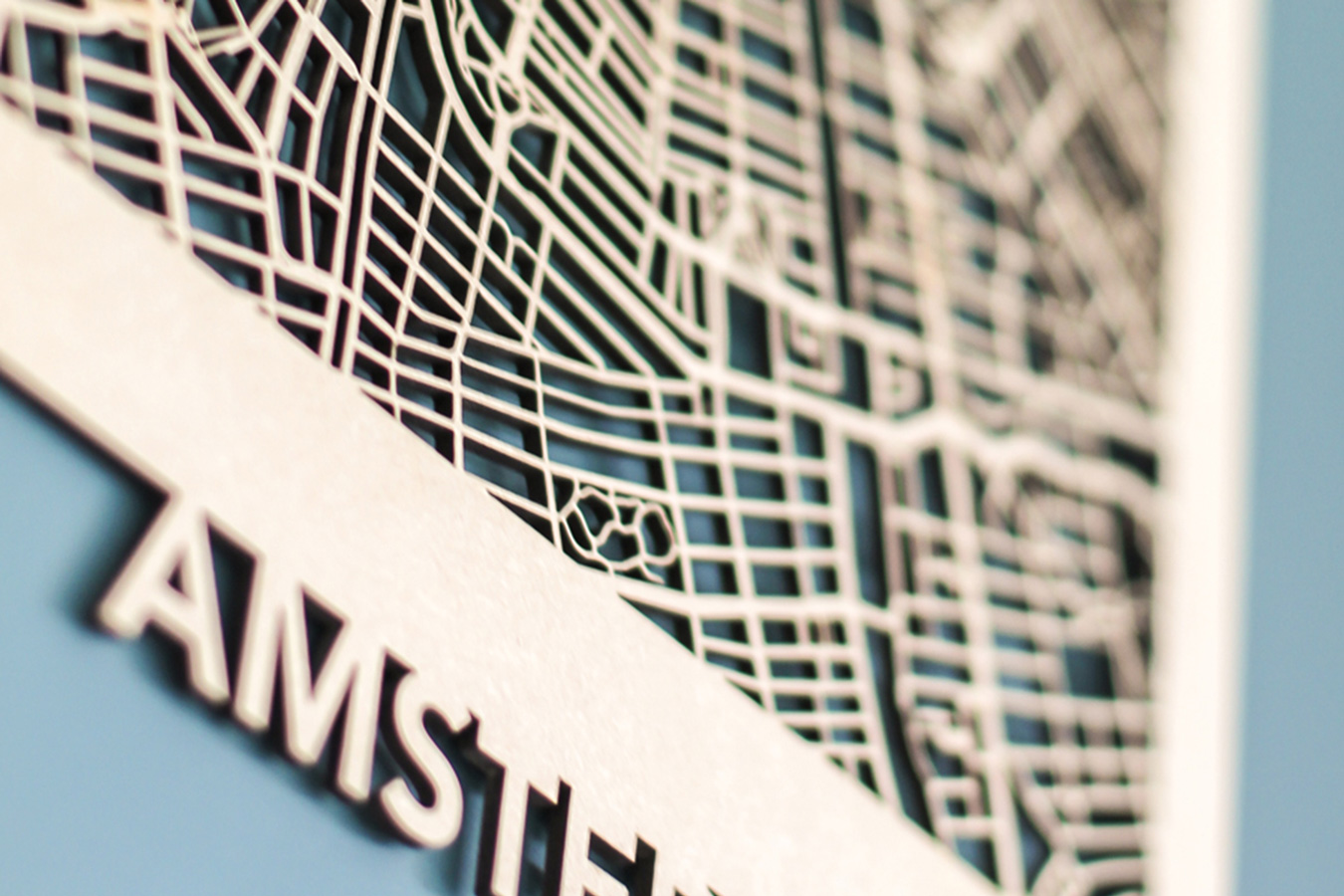
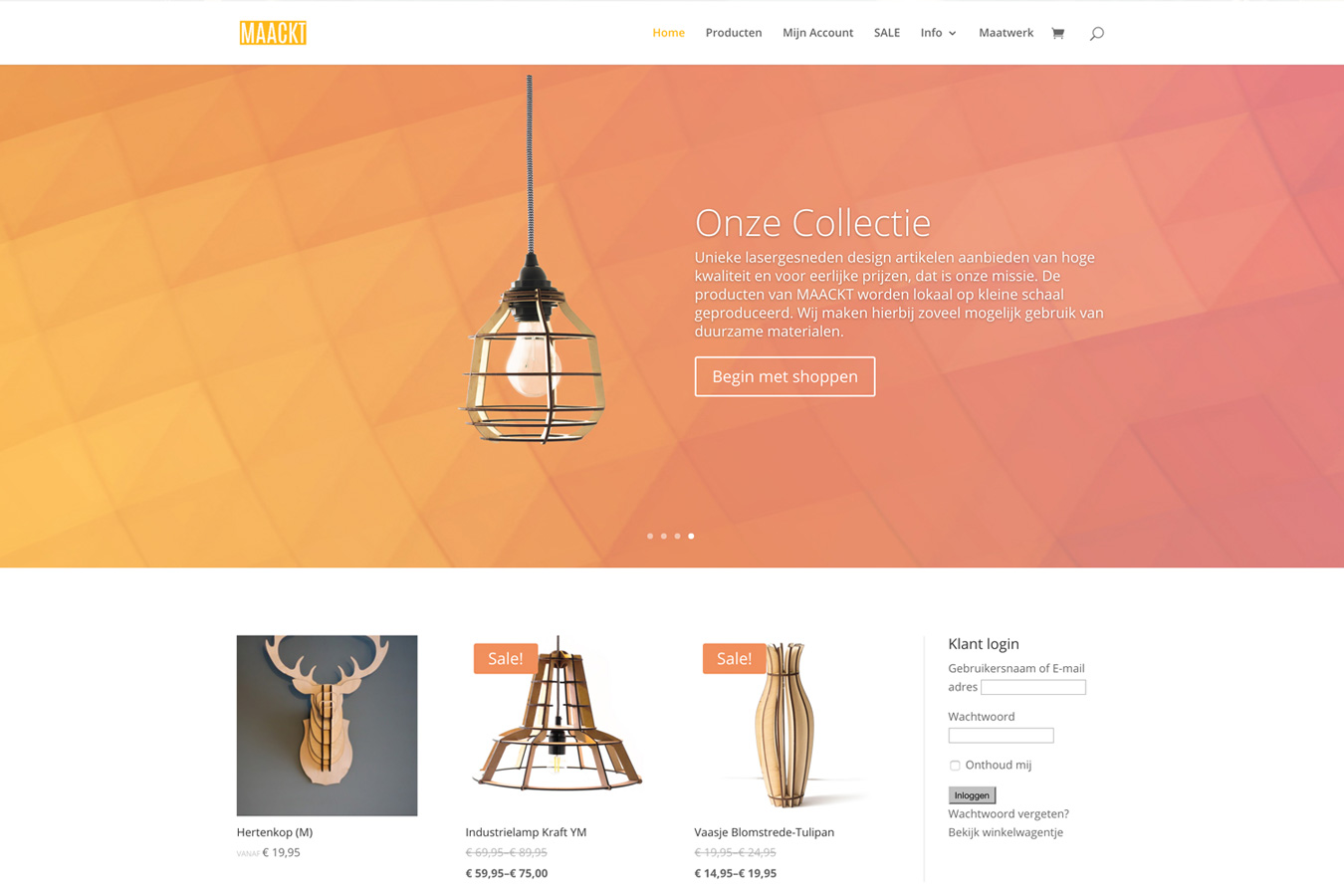
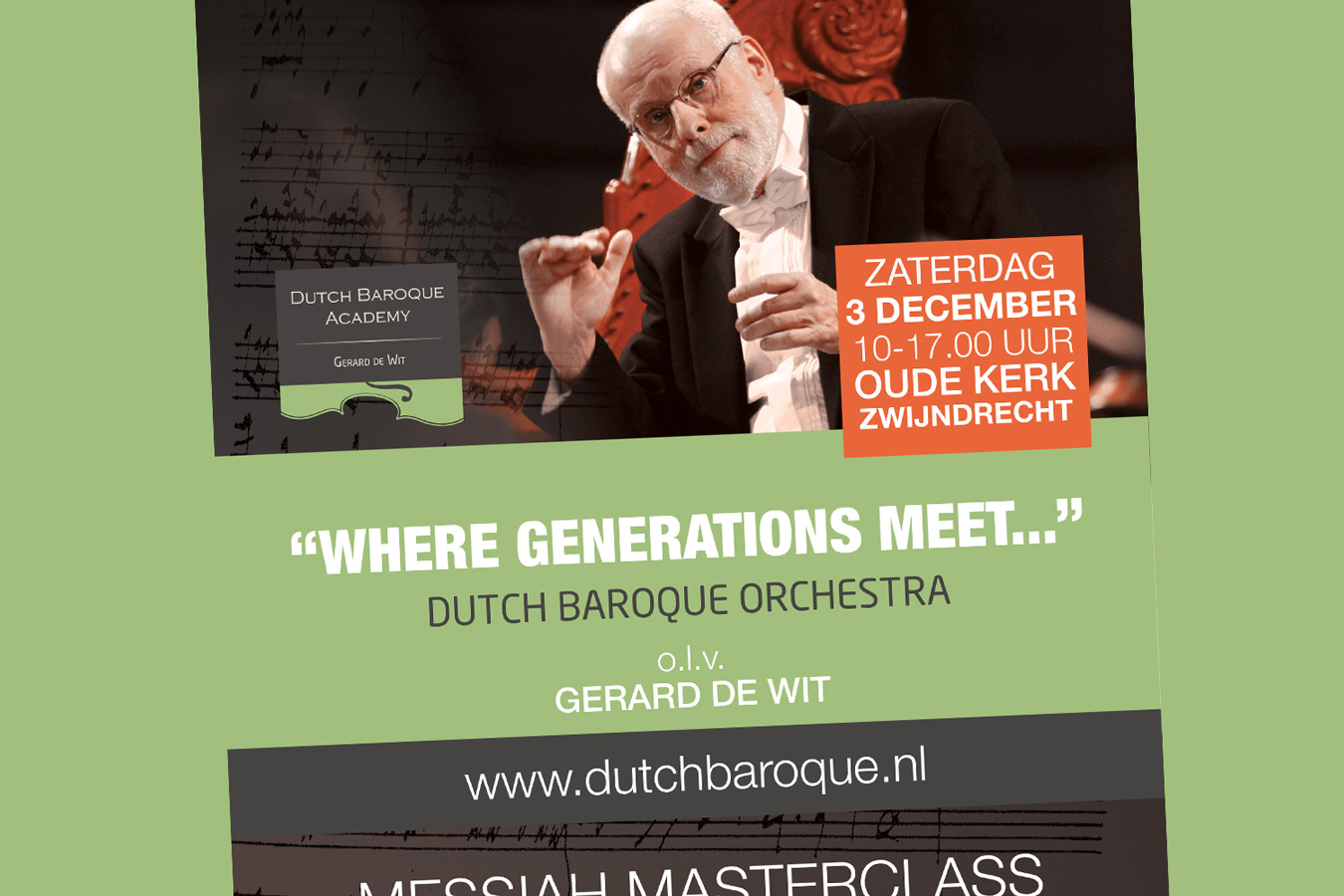

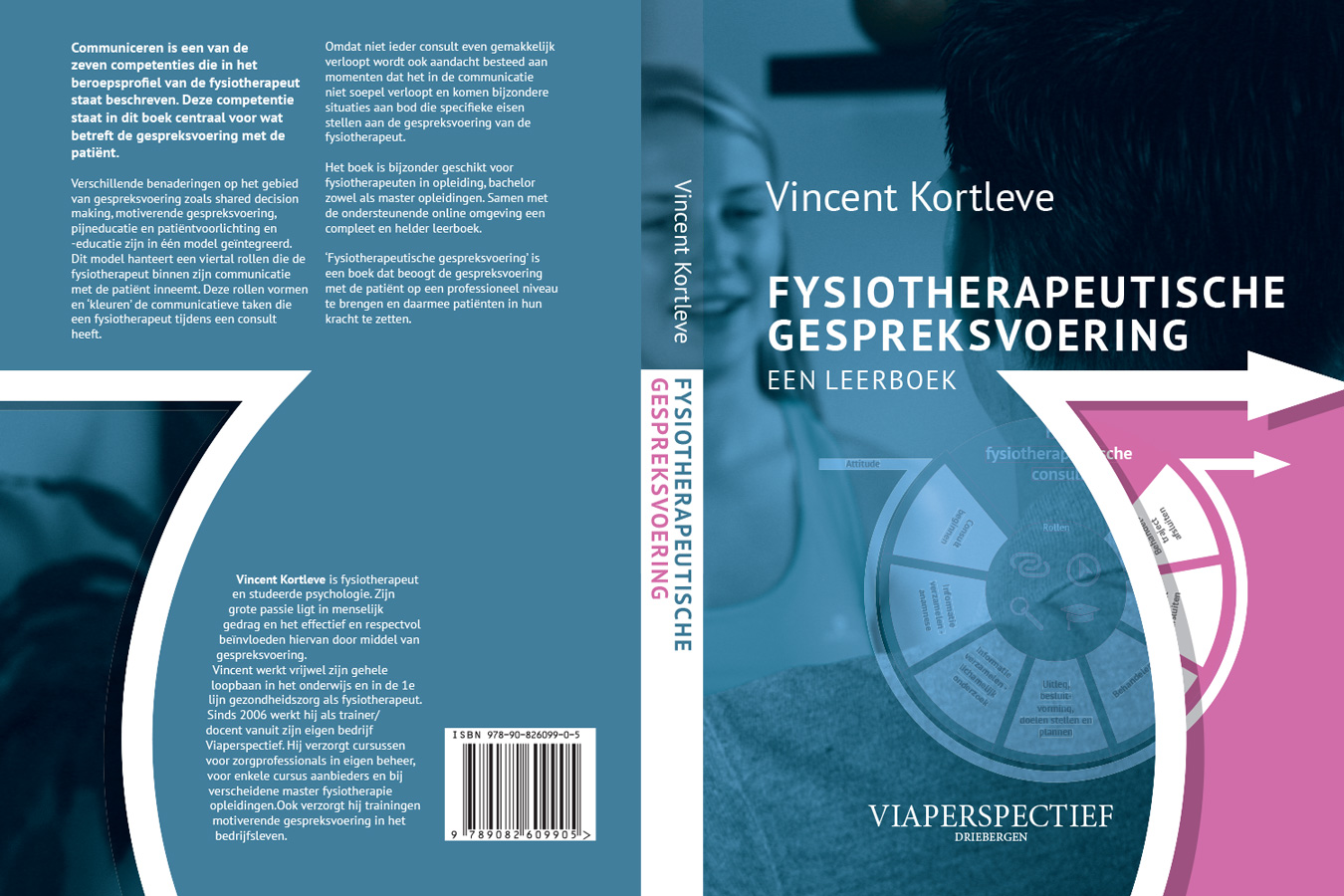
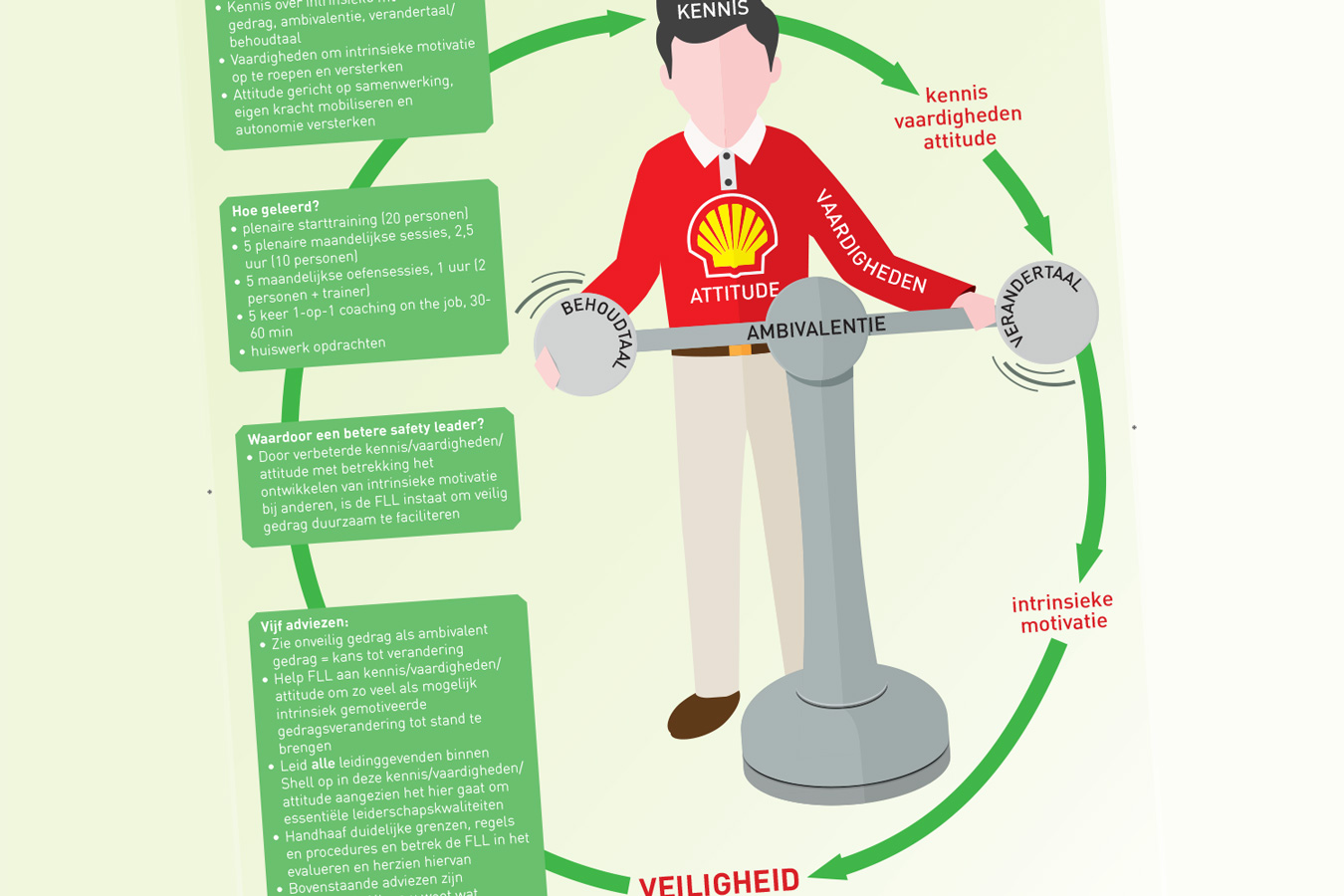


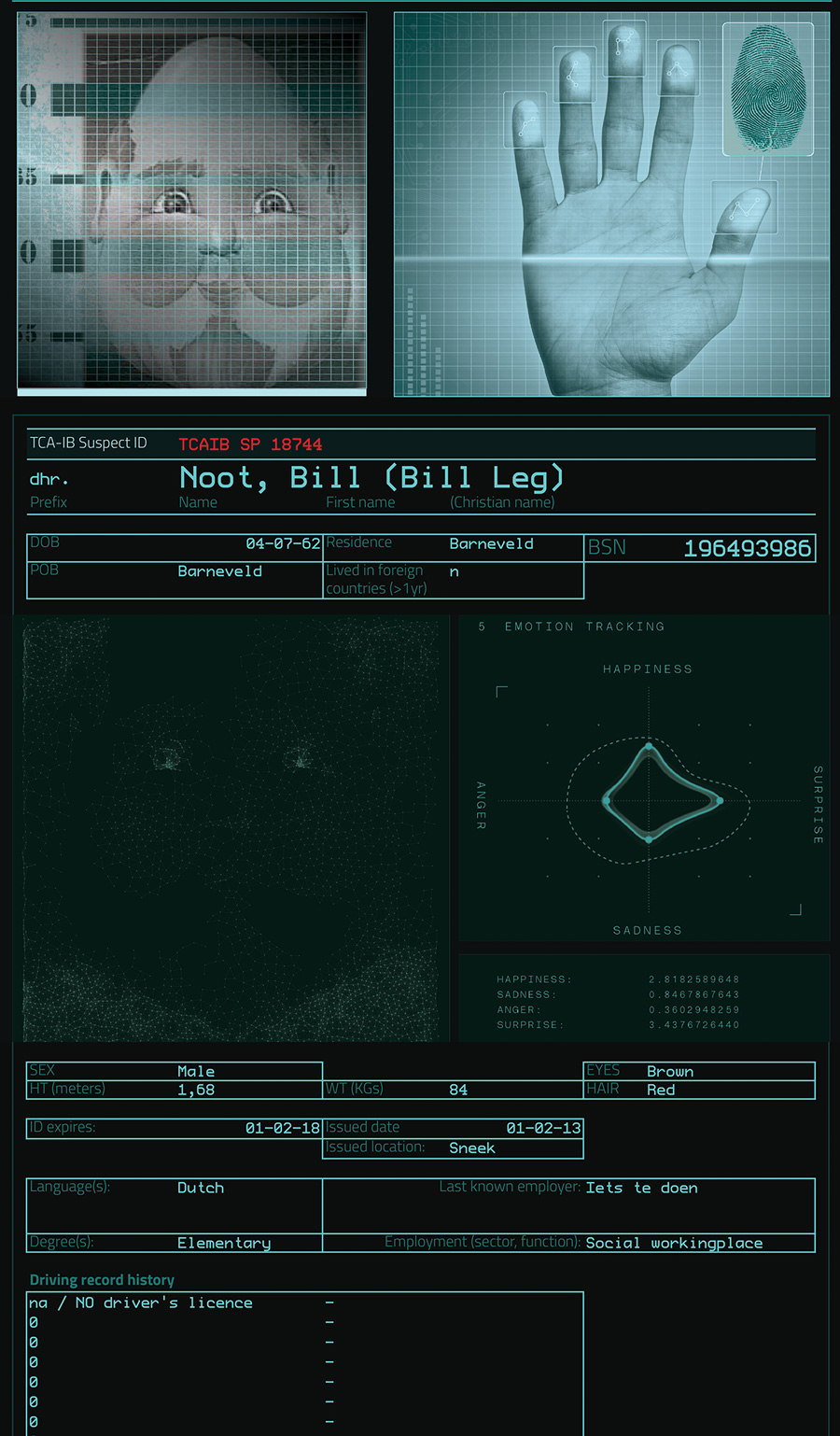


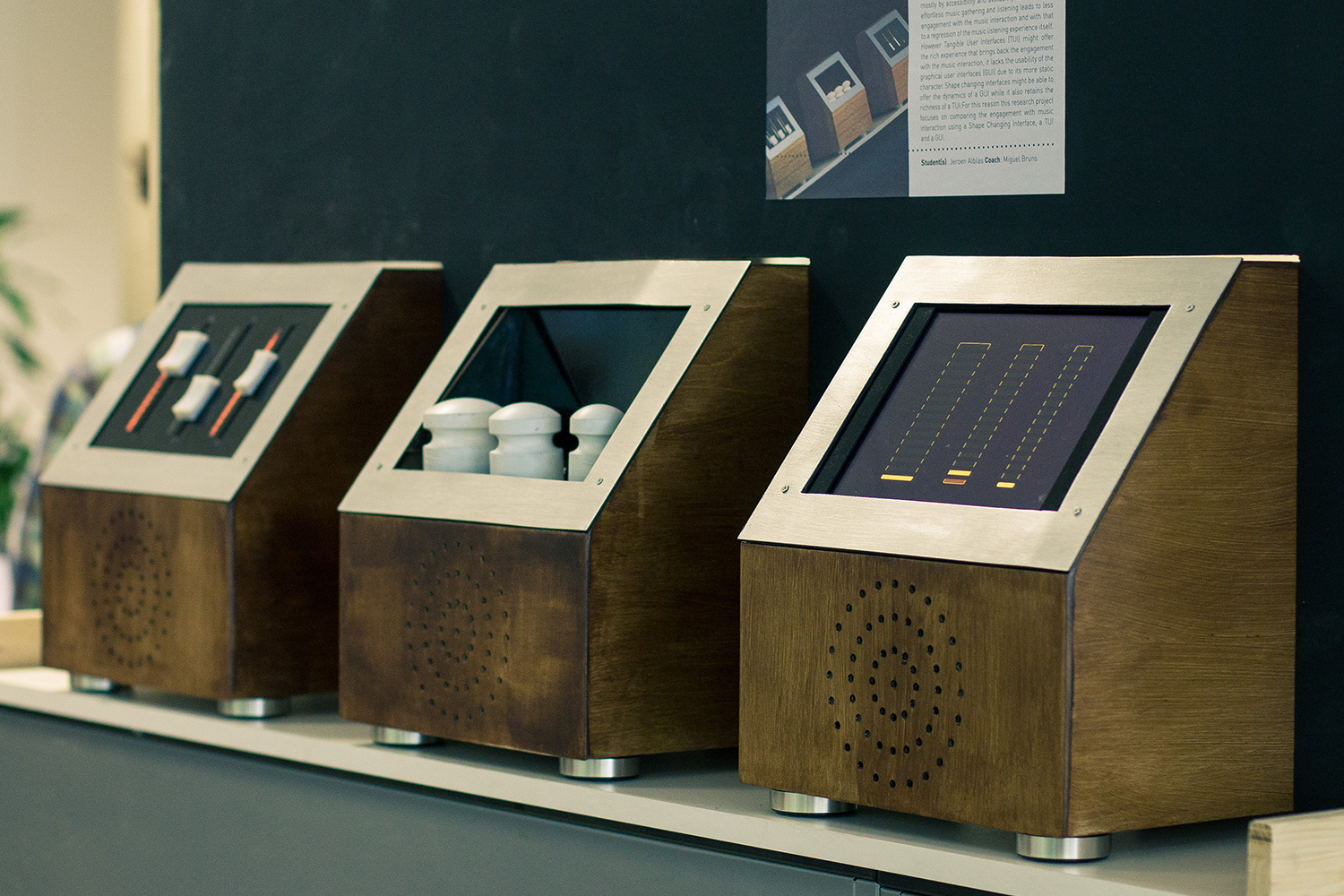
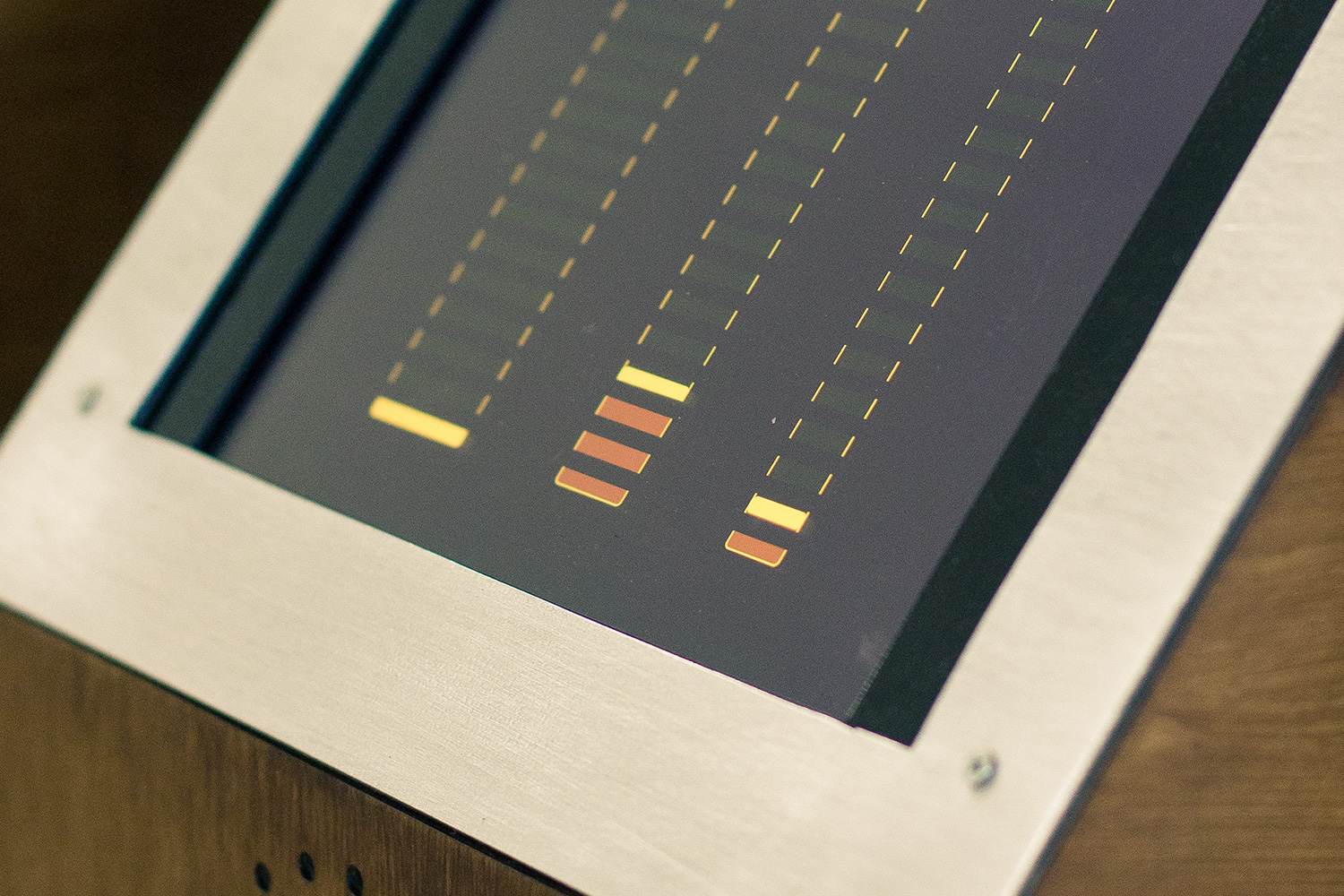

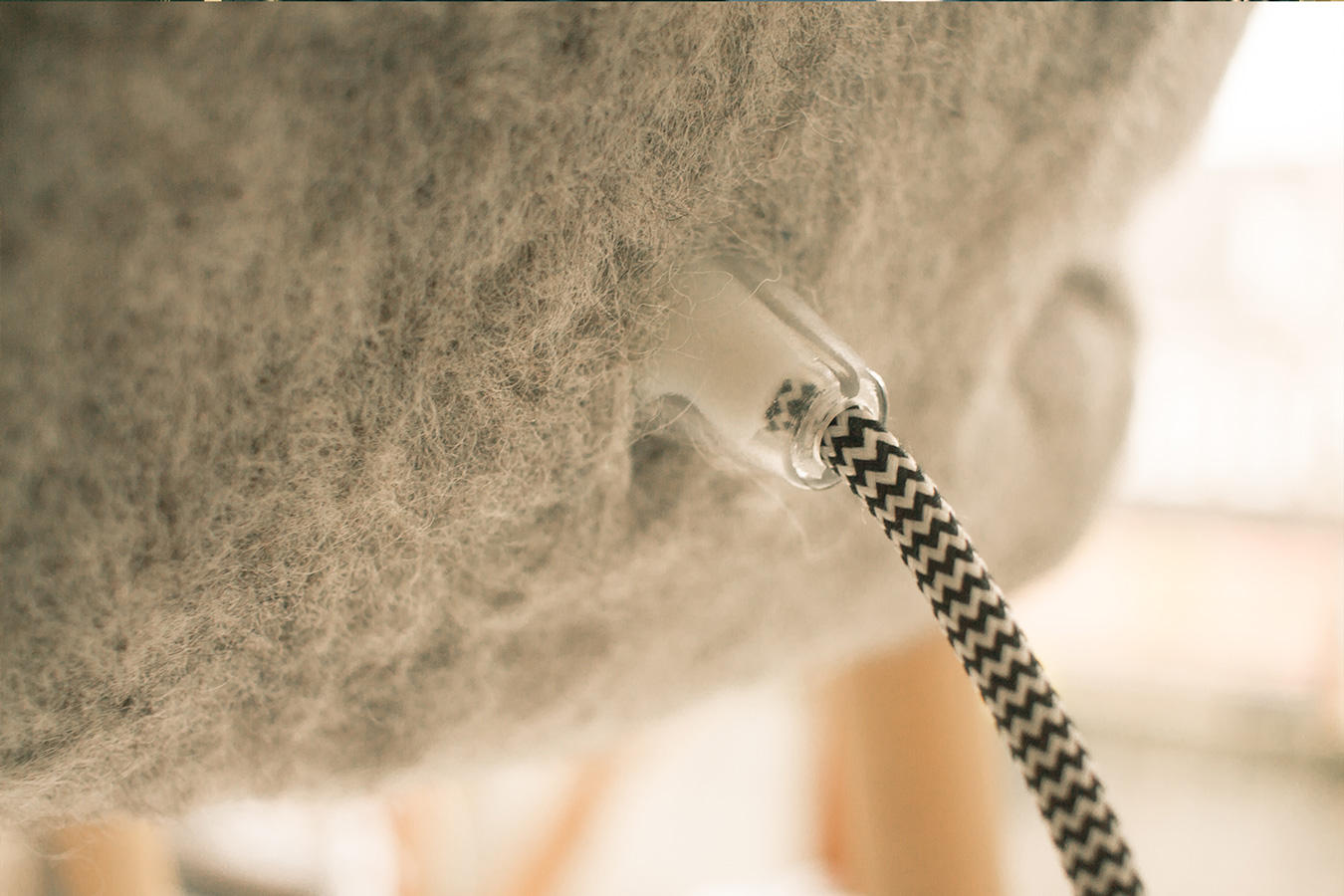
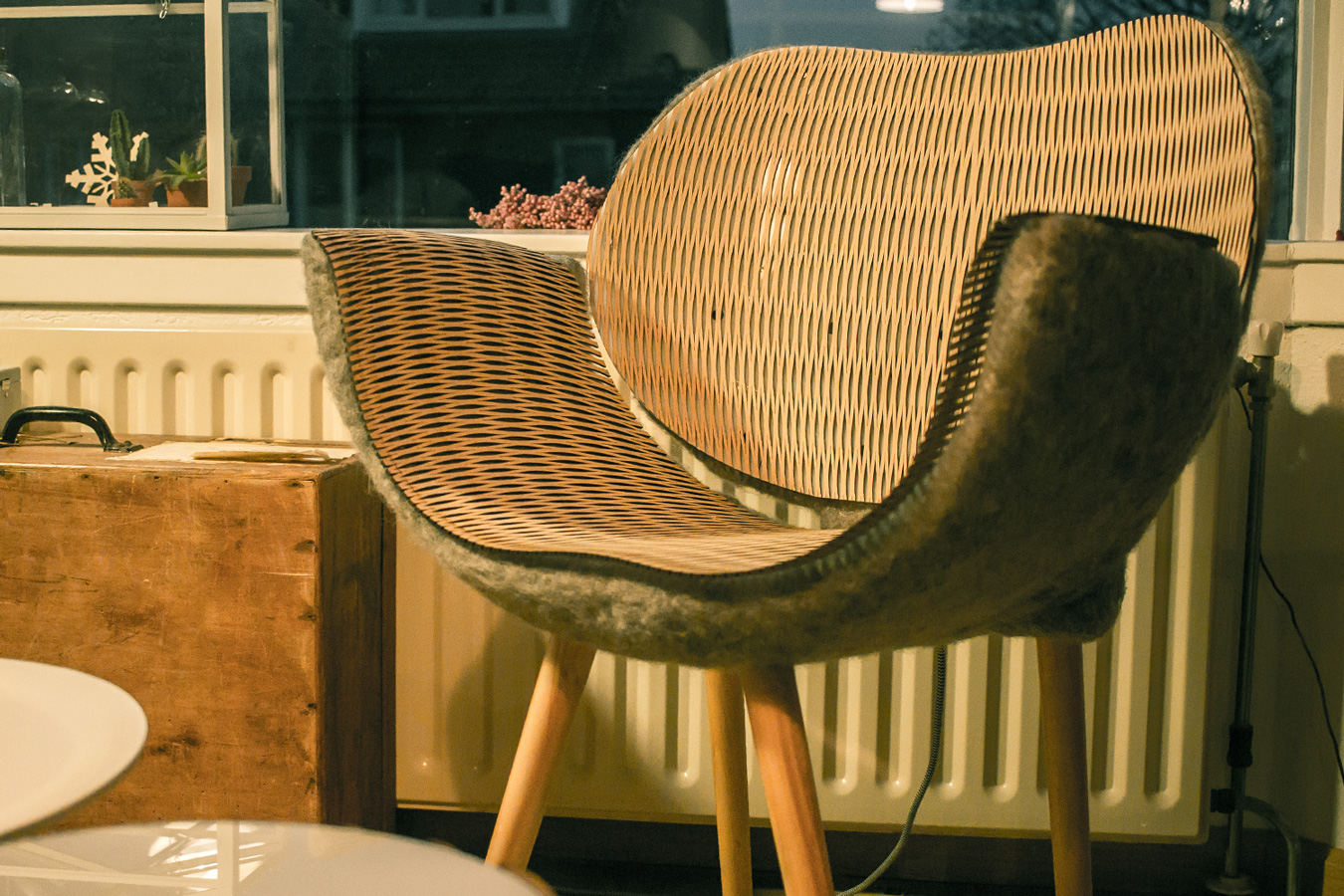
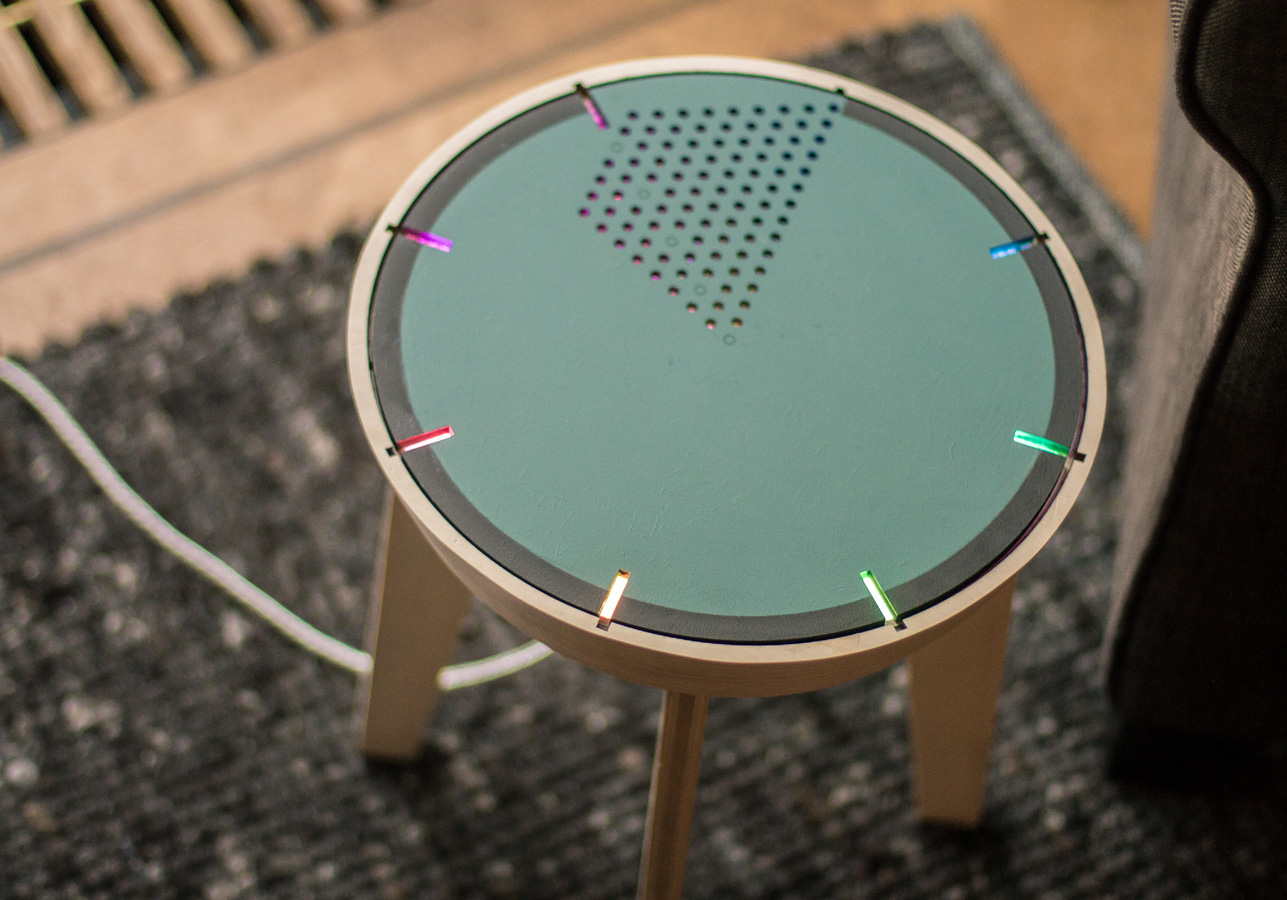

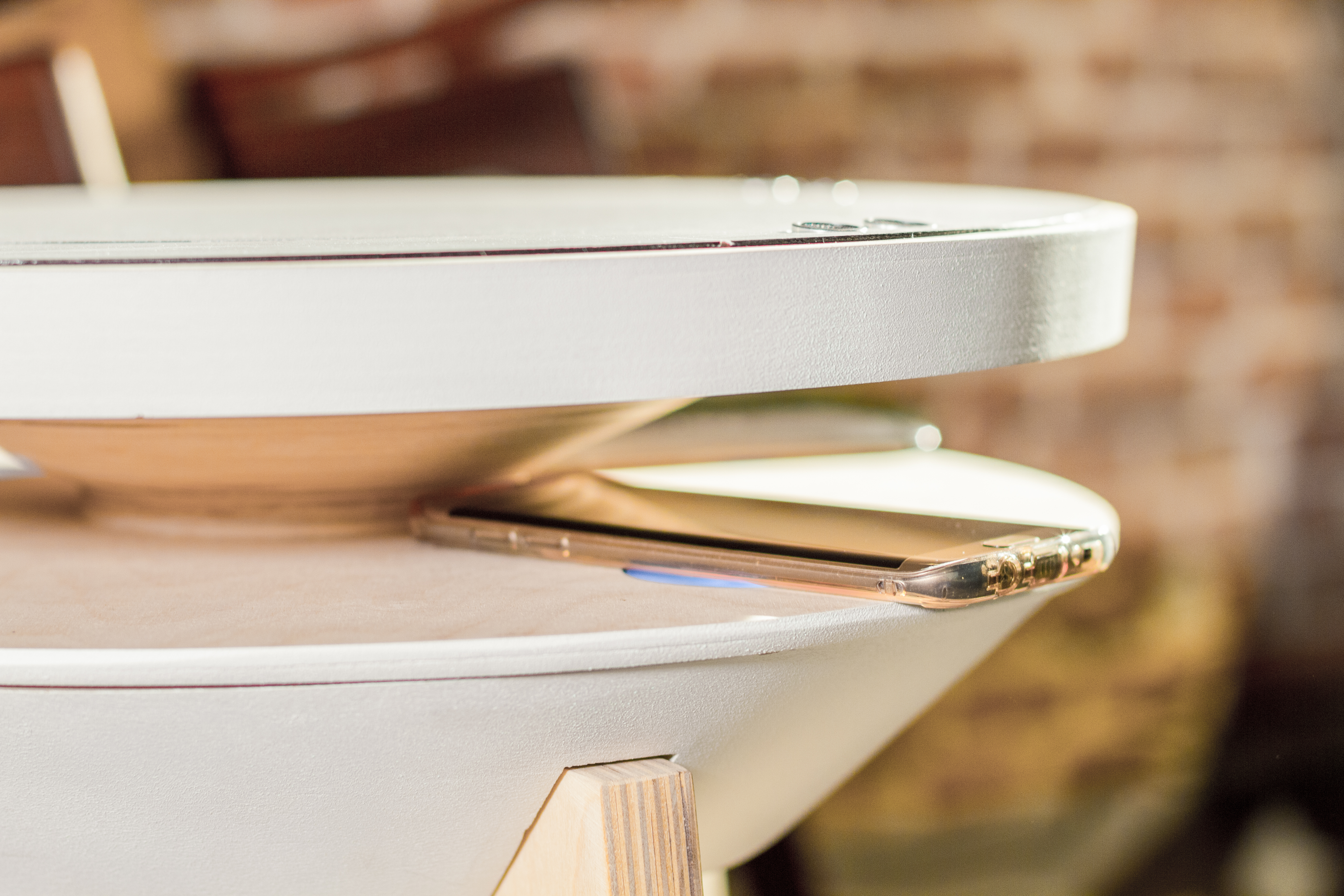
For the time being
Design for social Innovation
This elective was mainly about embodied perception and social design theories. People with dementia was the field we had to design for. In the end an exhibition was held that gave visitors the possibility to use and watch several interventions in a first person perspective. (Experiencing, being someone with dementia) We presented our concept ‘For the Time being’. Download report.
User and Society, Design Research Process, Technology and realization
Read more
Therefore we developed a concept that allows users to make up a clock out of objects that represent activities they value and/or think are important. They can start setting this clock in their early stage of dementia. During specific moments in the day, specific objects are visible or highlighted. This allows the people with dementia to self-design their days in a later stage of dementia.
In a later dementia stage, also the caregiver can have an influence on what is inside the clock. But is it important that the person with dementia has a moment of memory or reflection when seeing and touching the objects.
The exhibition set-up showed an abstraction of what we had in mind for a sensuous home environment with our concept. In the exhibition setting, we wanted to let the visitors experience both the first person’s perspective but also take a step back, reflect and think about how they would fill in this routine.
The final prototype that was presented at the exhibition, contained out of a round, turning table where different objects were placed on. Through rotation of the table objects passed one by one in a frame that highlighted one current-time object.
To give a feeling of how a person with dementia could feel about time, one of the windows showed a a time-lapse projection of which speed could be altered with a slider. In this way we asked visitors to match the time with the object shown in the frame. I made a short impression video of the final prototype.
Reflection I chose this elective because I was interested in getting acquainted with embodied perception and social design theories and frameworks to add those to my ideation ‘toolkit’.
The visit at GGzE was way out of my comfort zone, especially since we where unprepared. It turned out to be a very positive experience though, in which I regained my confidence in improvising. Also emphatically this visit had a huge impact on me. Not having any close experience with dementia leaves one knowing things about it but not fully comprehending the consequences of it. To see things that seem small in my own daily live deteriorating, actually made the most impact.
Lego has always been my favorite construction and building toy. The weird thing is that I always kept thinking of it as a toy. Using it as means of prototyping was amazing. It allows you to very quickly make mechanical prototypes that would otherwise need a lot of specific parts. In the same process I also saw the limits of the Lego prototyping. Using it with the heavy final prototype turned out to be a bit too far fetched.
This course gained me knowledge on my competencies of Aesthetics and Creativity and User and Society. The final prototype is fully aimed at how aesthetics evoke the experience we envisioned. Also the emotional experience is something that I gained more recognition for. The experiments showed me that it is very powerful. Embodied design is something that I can add to my ideation toolkit. Especially in exploring the design space, I really felt that this sparked creativity.